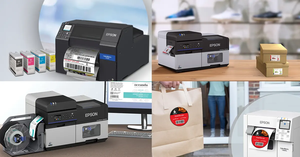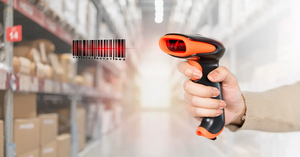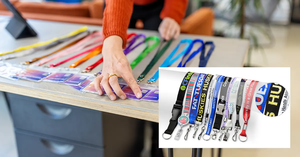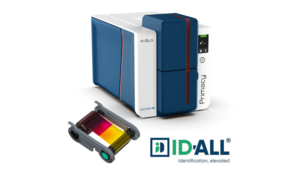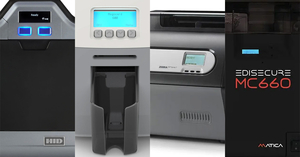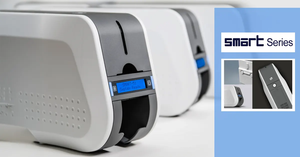Laminating ID Card Printers
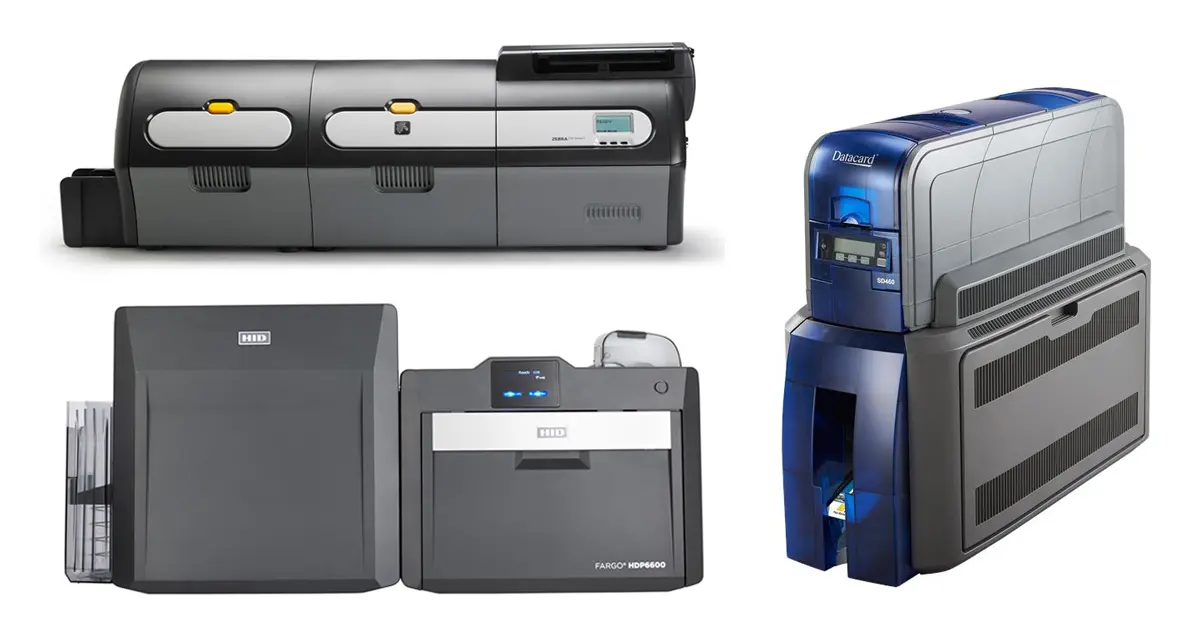
If you’ve been looking for an ID-card printer you’re probably already aware that selecting the right printer with the right features to meet your needs is a daunting task. If you’re ID cards must maximize security and/or durability, the important printer features/functions addressed below need your careful attention.
In plastic/PVC ID card and badge printing, lamination is a secondary process using heat and pressure to apply a clear layer of polyester film (laminate) over the card’s surface using a heated lamination module just after the card design is printed. Laminating ID cards is important and quite useful for several key reasons.
The laminate film acts as a barrier protecting printed images, text, and graphics from everyday wear and fading and maximizes durability and protection from abrasion, UV radiation, color fading and dye-migration—enabling cards to withstand heavy daily use and occasional negligent treatment. (Dye migration can occur when a printed ID card is within a plastic badge holder that is exposed to heat—like when you leave it in a sunbaked car—transferring part of the card image to the badge holder when pealing the two “stuck” surfaces apart.)
Lamination extends ID-card life by improving scratch resistance and protecting them from wear. The images and text on laminated cards remain true to color for years longer than nonlaminated cards.
Beyond improving card durability, this added protective layer also makes cards harder to tamper with and counterfeit, which increases security, reduces forgery risks, and offers better protection from counterfeiters.
Lamination capabilities are typically found as upgrade options on many higher-level direct-to-card and retransfer ID-card printers, which can laminate cards with upgradable lamination modules featuring single- and/or dual-sided lamination options. Card printers with lamination capability (aka laminating ID card printers or lamination card printers) apply laminate during the regular printing process—it’s simple and quick! The two-step lamination process adds a clear film to the card (on one or both sides, depending on printer capability) immediately after printing the card design using a built-in or field-upgradable heated lamination module (within or attached to the ID-card printer)—which heats the laminate film using the printhead. The varnish or film is applied at a very high temperature—beyond the reach of traditional print heads—which requires special equipment: a laminator.
Is Lamination Right for You?
To ensure higher levels of card durability and security (tamper resistance), many organizations laminate their cards with a laminating ID card printer. Lamination can be done on one or both sides of an ID card, depending on the printer’s configuration options. If you’re wondering if laminating ID cards is appropriate for your organization, consider that lamination is typically best for:
- Programs that require long-lasting ID cards. E.g., employee and student IDs, driver’s licenses, debit cards; also, if cardholders work outdoors, often leave their ID card in vehicles or store them in wallets, lamination is a must. These programs need lamination to give your cards a longer life.
- Frequently swiped payment and access-control cards. If your cards are regularly swiped through a magnetic stripe reader, lamination is for you.
- Minimizing/preventing card tampering, duplication, or forgery. If you require secure, difficult-to-duplicate ID cards, holographic lamination is recommended.
Examples of ID Card Issuers Choosing Lamination
- Airports and Port Authorities — Lamination protects the ID cards from damage due to exposure to harsh sun and rain for users working in mixed environments.
- Colleges, Large Institutions, Universities — Lamination helps frequently used cards hold up for on-campus students/employees using their ID cards throughout the day for multiple functions.
- Government — In high-security environments authenticating government ID cards is made easier and more reliable by adding another layer of security—holographic overlaminates.
- Military — Custom-sized overlaminates protect cards displayed and used daily with embedded electronics like smart chips.
Clear, Holographic or Custom Hologram Options Are Available with Lamination.
Lamination increases card security by adding another barrier to fraudulent alteration. For even more security, lamination film that includes holographic images renders your ID cards completely distinctive.
Printer makers offering over-lamination capability also provide holographic versions of their laminate material. Holographic laminates appear as “watermarks” on ID cards, and contain hard-to-duplicate designs. Lamination renders the watermark hard to tamper with. They’re applied over the card design allowing the underlying images to remain unobscured. These vary, but commonly employ a holographic image embedded on the overlaminate’s surface. Some preconfigured holographic overlaminates also feature microtext printing within the holographic image to enhance fraud protection and security.
Holograms —Holograms are 3D images added to ID cards by way of holographic laminates that help reduce the possibility of successful card reproduction. They are versatile and can add diverse visual security elements to ID cards that allow for quick visual authentication. The laminates are thin transparent films that contain holographic text, images, and patterns (created by the user or preconfigured). On higher-level standard and custom holographic overlaminates, custom micro-text printing is an option. To be visible or appear, holograms are typically viewed at an angle by tilting the card. To produce holograms, users need ID card printers with a laminating module and holographic overlaminates.
Generic hologram designs developed by the overlaminate material manufacturers are most common (these are considered “off-the-shelf”), but if you’re looking for highly customized holographic security, custom holographic solutions can be developed, and many ID card printers with over-lamination capability allow users to create custom holographic designs for even greater security—and brand enhancement.
Depending on the printer model, users can select a holographic laminate film that best suits their needs from many styles and designs offered by the printer and laminate manufacturers.
- Clear laminates: a clear protective layer of 0.6 or 1.0 mil is applied to your printed cards.
- Standard holographic laminates: choose laminates with holograms for added security as holograms are hard to duplicate.
- Custom holographic laminates: instead of opting for a standard hologram that another company may also use, go for your own custom design. This option guarantees maximum protection to your cards.
Holographic films undergo the same application process (just like a standard lamination film), but their holographic watermark design appears over the whole ID-card surface. With the watermark, detecting fake, damaged, fraudulent or tampered-with cards is much easier.
Each ID printer manufacturer offers its own set of holographic design options. Review your printer’s lamination options:
Tactile Impression
This feature uses a heating process to place a stamp on the card’s laminate during the printing process—leaving a physical impression on the cards that you can feel. It doesn’t require customized consumables, but uses a mechanical die within the card printer’s lamination unit that can be stock or customized. This is an advanced security enhancement.
Laminating Supplies and Costs
What supplies are needed for a laminating printer? Laminating ID-card printers require overlaminate supplies: laminate rolls/ribbons and heat-resistant composite PVC-PET cards—in addition to regular printer ribbons.
Laminate films can be patches (applied to part of the card) or overlay (applied to the entire card surface)—and each type can be translucent (protects against UV radiation) and/or feature holograms (enhancing security). Patch laminates leave an unprotected border around the edge of your cards while overlay laminates (overlaminates) cover the entire card surface. To laminate magnetic-stripe cards, smart cards, or signature-panel cards, specialized lamination ribbons are available that avoid laminating over those portions of the card. Or, patch laminates can be used to laminate half of a card, a magnetic stripe card, or elements of a smart card.
Note: One form of laminate is an “overlay” (aka a “topcoat” or “varnish”) applied within the printing process itself. Most of the ribbons used for card printers have a clear panel, called a varnish overlay (E.g., in a 5-panel YMCKO ribbon, the "O" is the overlay (the transparent panel)). The overlay ribbon applies a clear thin layer (about .25 mil thickness) to cards, edge to edge. This “printed” overlay protects barcodes, signatures, logos and images against friction wear, fading and prevent dye re-sublimation—for up to three years. Overlay laminates are for applications requiring medium durability and minimal tamper resistance.
The varnish overlay is considered a "light" protective coat. It provides little protection against abrasion and is not to be confused with laminate film, which is applied in a separate thermal process after printing. Laminate film is separate from the printer ribbon and comes in its own cartridge. It’s a "thicker" protective coat (thickness varies from .5 mil to 1.0 mil which users can choose depending on their needs) providing significant protection against abrasion (shielding the card itself from wear and tear), and can extend card life from 3 to 10 years. Thicker laminate films increase card durability and life. Laminate film is preferred for cards that are physically "swiped" to read its barcode and/or subject to severe conditions/exposure.
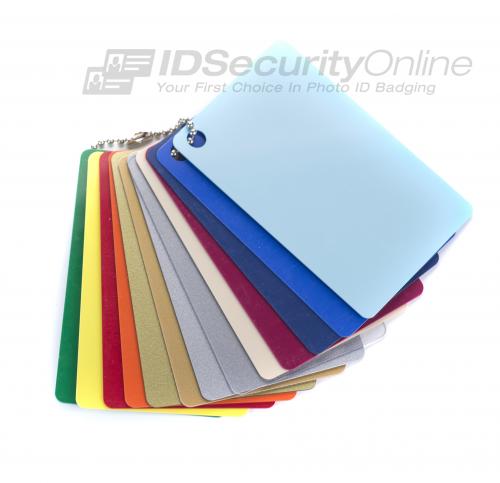
Composite PVC-PET Cards
Card material: the most common type of plastic card is 100% PVC. However, it is recommended to use composite PVC/PET cards for retransfer and laminating printers. Composite PVC-PET cards are the same size as standard PVC cards (and look the same), but are 60% PVC and 40% PET and are more durable than PVC cards. Importantly, they’re far better able to resist the high heat used in the lamination process and won’t bend under high temperatures (standard 100% PVC cards will warp from the intense heat when laminating). Composite cards can be used with any card printer.
So, the cost-per-card is higher than with a non-laminating system. Moreover, upgrading to lamination typically adds $1,200 – $3,000 to the printer’s cost, and $.22 – $.65 to per-card supply costs.
Our featured preferred laminating printer choices are:
- Fargo HDP6600 Lamination ID Card Printers
- Zebra ZXP Series 7 Dual Sided ID Card Printer with Lamination
- Datacard SD460 Dual Sided ID Card Printer with Lamination
The IDSecurityOnline Difference
Each ID card printing system offered by IDSecurityOnline has options for adding overlays or a laminating module. If you think your ID cards need added protection, our experts can help you determine whether an overlay or a laminate film best meets your needs. We’ll help you weigh the costs of each option against the enhancements/protections to arrive at a solution that meets your ID security needs and your budget.
Call one of our experts today to discuss your ID security requirements. You’ll be happy to learn that we strive to exceed your expectations with first-class customer support and service, free shipping, and a price match guarantee.
Questions?
If you need more information on—or assistance with—understanding lamination for your organization’s ID cards and badges, contact one of our ID Experts at 800-897-7024 or sales@idsecurityonline.com. We’ll make it easy for you!
